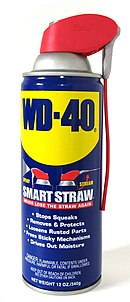|
WD-40
 WD-40 (Water Displacement, 40th formula) is an American brand and the trademark of a penetrating oil manufactured by the WD-40 Company based in San Diego, California.[1] Its formula was invented for the Rocket Chemical Company in 1953, before it became the WD-40 Company. WD-40 became available as a commercial product in 1961.[2] It acts as a lubricant, rust preventive, penetrant and moisture displacer. There are specialized products that perform better than WD-40 in many of these uses, but WD-40's flexibility has given it fame as a jack of all trades.[3] It is a successful product to this day, with steady growth in net income from $27 million in 2008 to $70.2 million in 2021.[4] In 2014, it was inducted into the International Air & Space Hall of Fame at the San Diego Air & Space Museum.[5] HistorySources credit different people with inventing WD-40 formula in 1953 as part of the Rocket Chemical Company (later renamed to the WD-40 Company), in San Diego, California; the formula was kept as a trade secret and was never patented.[6] According to Iris Engstrand, a historian of San Diego and California history at the University of San Diego, Iver Norman Lawson invented the formula,[7] while the WD-40 company website and other books and newspapers credit Norman B. Larsen. According to Engstrand, "(Iver Norman) Lawson was acknowledged at the time, but his name later became confused with company president Norman B. Larsen."[8][9][6] "WD-40" is abbreviated from the term "Water Displacement, 40th formula",[10] suggesting it was the result of the 40th attempt to create the product.[1] The spray, composed of various hydrocarbons, was originally designed to be used by Convair to protect the outer skin of the Atlas missile from rust and corrosion.[11][12] This outer skin also functioned as the outer wall of the missile's delicate balloon tanks. WD-40 was later found to have many household uses[1] and was made available to consumers in San Diego in 1958.[11] In Engstrand's account, it was Iver Norman Lawson who came up with the water-displacing mixture after working at home and turned it over to the Rocket Chemical Company for the sum of $500 (equivalent to $5,700 in 2023). It was Norman Larsen, president of the company, who had the idea of packaging it in aerosol cans and marketed it in this way.[7] It was written up as a new consumer product in 1961.[13] By 1965 it was being used by airlines including Delta and United; United, for example, was using it on fixed and movable joints of their DC-8 and Boeing 720s in maintenance and overhaul.[14] At that time, airlines were using a variant called WD-60 to clean turbines, removing light rust from control lines, and when handling or storing metal parts.[14] By 1969 WD-40 was being marketed to farmers and mechanics in England.[15] In 1973, WD-40 Company, Inc., went public with its first stock offering. Its NASDAQ stock symbol is (Nasdaq: WDFC).[16] FormulationWD-40's formula is a trade secret.[17] The original copy of the formula was moved to a secure bank vault in San Diego in 2018.[18] To avoid disclosing its composition, the product was not patented in 1953, and the window of opportunity for patenting it has long since closed.[12] WD-40's main ingredients as supplied in aerosol cans, according to the US material safety data sheet information,[19] and with the CAS numbers interpreted:[20]
The European formulation[21] is stated according to the REACH regulations:
The Australian formulation[22] is stated:
In 2009, Wired published an article with the results of gas chromatography and mass spectrometry tests on WD-40, showing that the principal components were C9 to C14 alkanes and mineral oil.[23] See alsoReferences
External linksWikimedia Commons has media related to WD-40. |
||||||||||||||
Portal di Ensiklopedia Dunia

